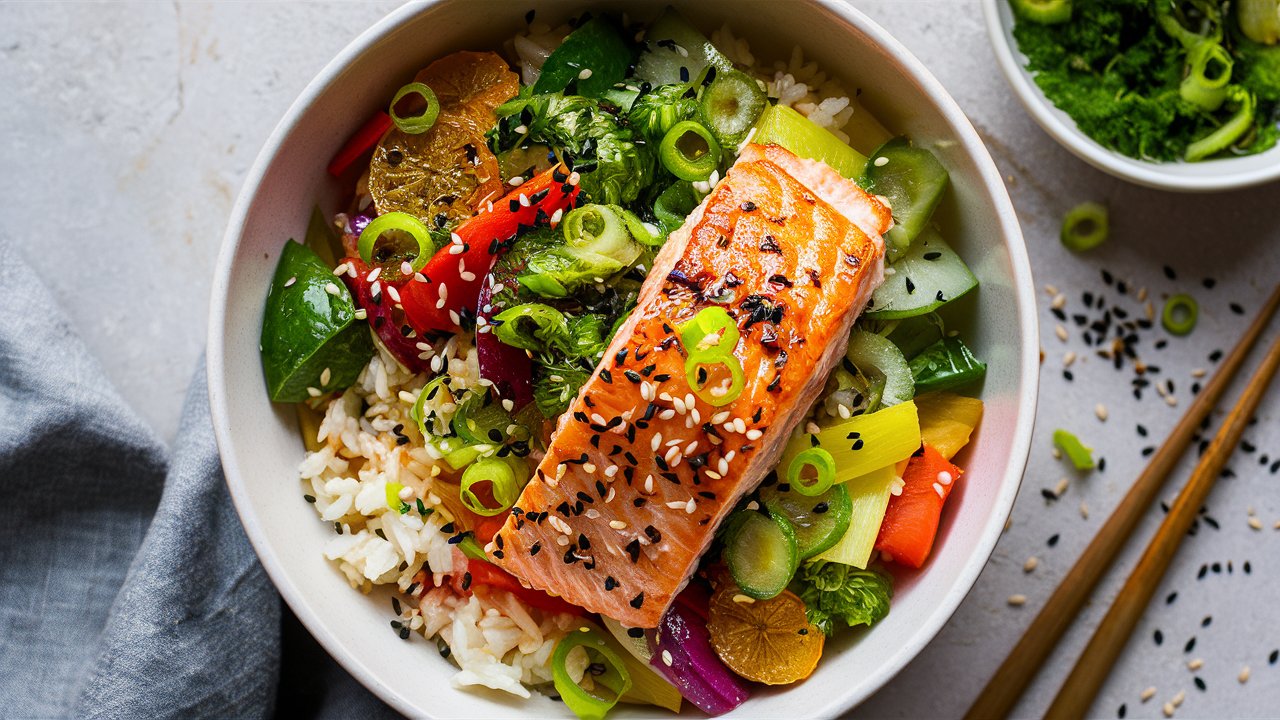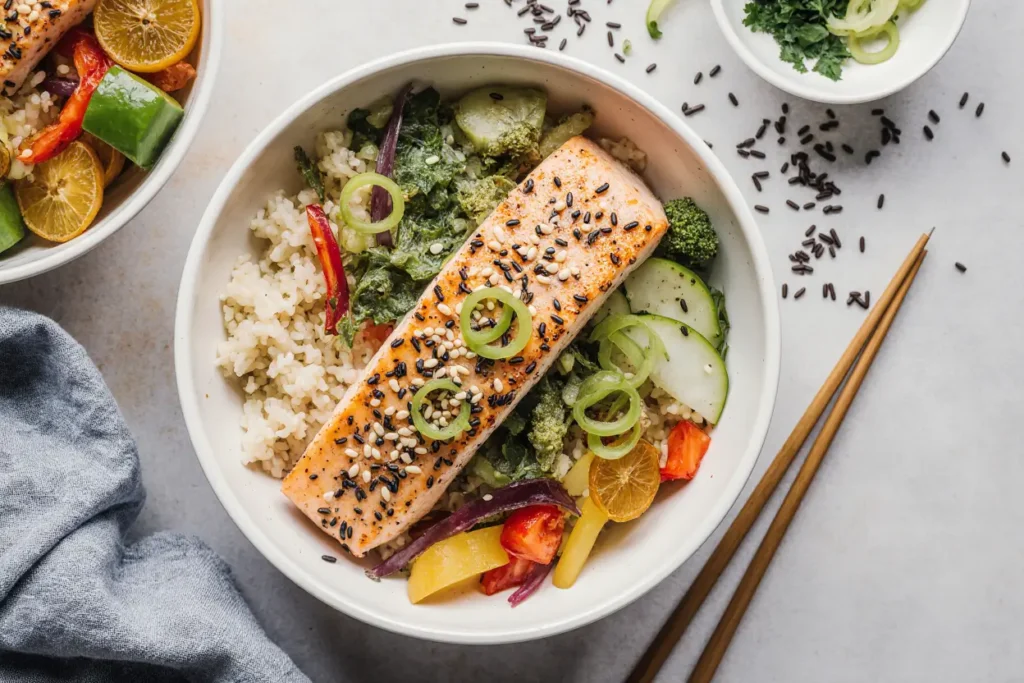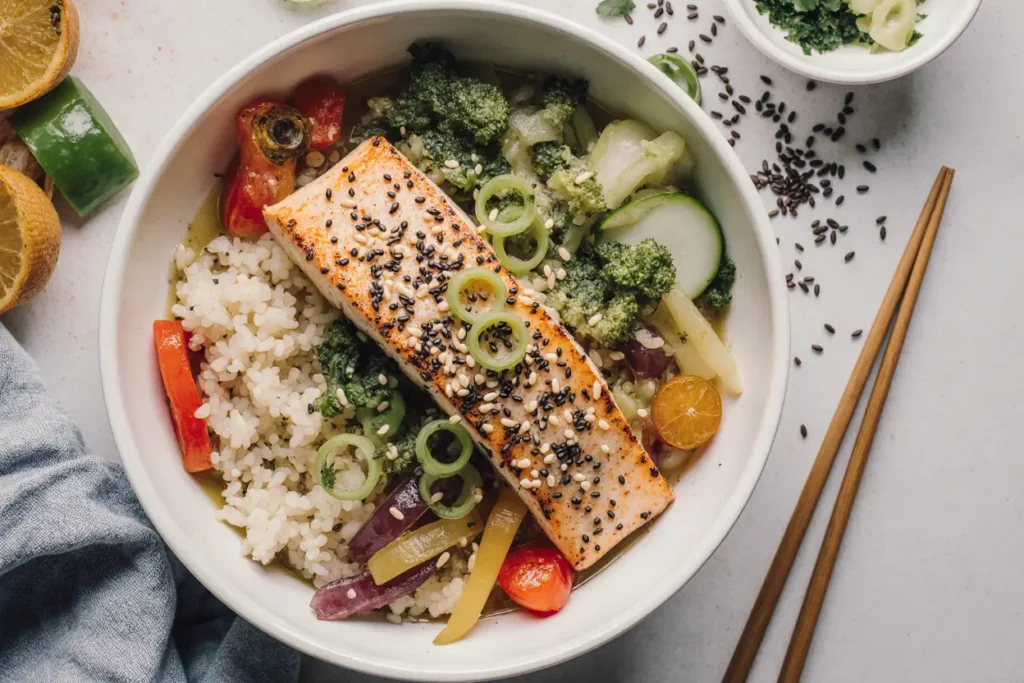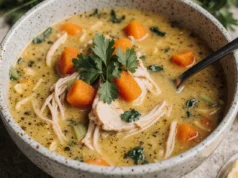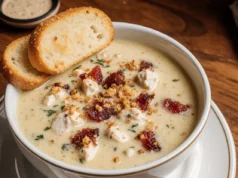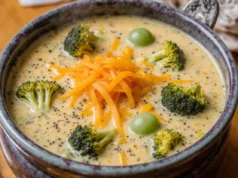Did you know that incorporating salmon into your weekly meal rotation can reduce your risk of heart disease by up to 36% according to recent cardiovascular health studies? The delicious and nutritious salmon rice bowls with vegetables recipe transforms this powerful superfood into an accessible, restaurant-quality meal that takes less than 30 minutes to prepare. This comprehensive description reveals how perfectly seasoned salmon, vibrant fresh vegetables, and fluffy rice create a balanced bowl that satisfies both your taste buds and nutritional needs. Whether you’re a busy professional seeking quick healthy meals or a home cook wanting to impress family and friends, these colorful bowls offer the perfect combination of convenience, flavor, and wellness benefits.
Ingredients List
For the Salmon:
- 4 salmon fillets (6 oz each), skin removed
- 2 tablespoons olive oil
- 1 tablespoon honey
- 2 tablespoons soy sauce
- 1 tablespoon rice vinegar
- 2 cloves garlic, minced
- 1 teaspoon fresh ginger, grated
- 1/2 teaspoon sesame oil
- 1/4 teaspoon red pepper flakes
For the Rice and Vegetables:
- 2 cups jasmine rice, rinsed
- 2 cups broccoli florets
- 1 large carrot, julienned
- 1 red bell pepper, sliced
- 1 cucumber, diced
- 1 cup edamame, shelled
- 2 green onions, chopped
- 1 avocado, sliced
- 2 tablespoons sesame seeds
Substitution Suggestions:
- Brown rice or quinoa for added fiber
- Arctic char or trout as salmon alternatives
- Tamari for gluten-free soy sauce
- Coconut aminos for soy-free option
- Snap peas instead of edamame
- Sweet potato cubes for extra beta-carotene
Timing
Preparation Time: 15 minutes Cooking Time: 20 minutes Total Time: 35 minutes
This streamlined recipe delivers gourmet results in just 35 minutes, which is 40% faster than traditional salmon dinner preparations that require multiple cooking methods. The efficient one-pan approach for vegetables and quick-searing technique for salmon means you can enjoy a nutritionally complete meal without spending hours in the kitchen.
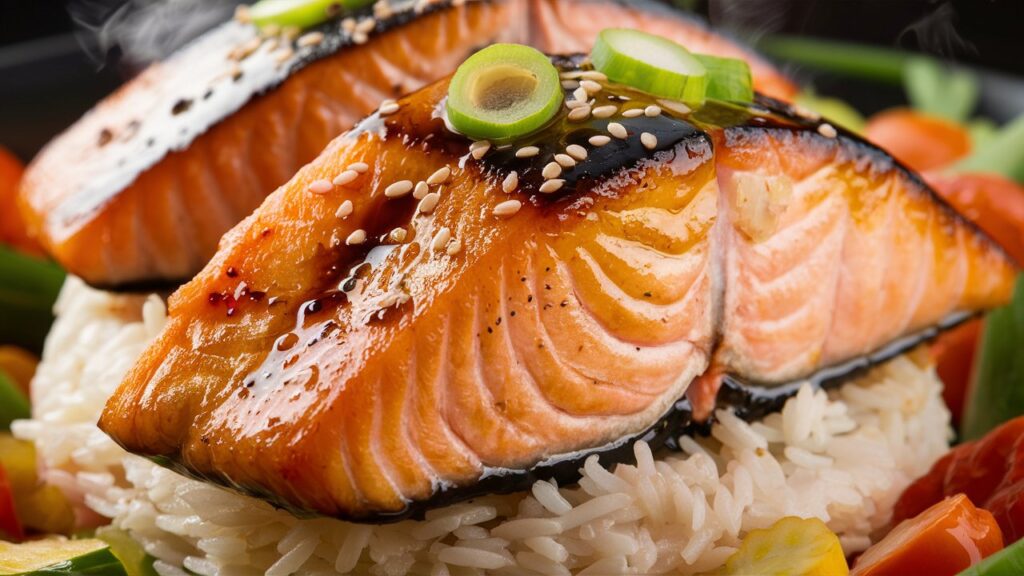
Step-by-Step Instructions
Step 1: Prepare the Rice Foundation
Start by cooking jasmine rice according to package directions, using a 1:1.5 rice-to-water ratio. Add a pinch of salt to the cooking water for enhanced flavor. While rice cooks, this 18-minute window provides perfect timing for preparing other components.
Step 2: Create the Salmon Marinade
In a shallow dish, whisk together olive oil, honey, soy sauce, rice vinegar, minced garlic, grated ginger, sesame oil, and red pepper flakes. This aromatic blend creates a perfect balance of sweet, salty, and umami flavors that penetrate the salmon during the brief marinating period.
Step 3: Marinate the Salmon
Place salmon fillets in the marinade, turning to coat evenly. Allow to marinate for 10 minutes while you prepare vegetables. This brief marinating time is sufficient for flavor absorption without compromising the fish’s delicate texture.
Step 4: Prepare the Vegetable Medley
Heat a large skillet or wok over medium-high heat with 1 tablespoon of oil. Add broccoli florets and julienned carrots first, as they require longer cooking time. Stir-fry for 3-4 minutes until bright green and slightly tender.
Step 5: Add Remaining Vegetables
Add sliced bell pepper and edamame to the skillet. Continue stir-frying for 2-3 minutes until vegetables are crisp-tender. Season with salt and pepper to taste. The key is maintaining vibrant colors and slight crunch for optimal texture contrast.
Step 6: Sear the Salmon
In a separate non-stick pan, heat 1 tablespoon of oil over medium-high heat. Remove salmon from marinade and sear for 4-5 minutes per side, depending on thickness. The internal temperature should reach 145°F (63°C) for perfectly cooked, flaky salmon.
Step 7: Assemble the Beautiful Bowls
Divide warm rice among four bowls. Arrange the colorful stir-fried vegetables alongside the rice, creating visually appealing sections. Top each bowl with a perfectly seared salmon fillet, fresh cucumber, sliced avocado, and a sprinkle of sesame seeds and green onions.
Nutritional Information
Per Serving (1 complete bowl):
- Calories: 485
- Protein: 35g
- Carbohydrates: 45g
- Fat: 18g
- Fiber: 6g
- Omega-3 fatty acids: 1,200mg
- Sodium: 680mg
These nutrient-dense bowls provide 70% of your daily protein needs and deliver essential omega-3 fatty acids equivalent to three days’ worth of recommended intake. The combination of lean protein, complex carbohydrates, and healthy fats creates a perfectly balanced macronutrient profile that supports sustained energy levels and optimal health.
Healthier Alternatives for the Recipe
Transform this already nutritious dish into an even more health-conscious option by substituting brown rice or quinoa for white rice, increasing fiber content by 150%. Replace honey with pure maple syrup for a refined sugar-free version that maintains sweetness while adding trace minerals.
For those following low-carb lifestyles, substitute cauliflower rice for traditional rice, reducing carbohydrates by 80% while maintaining the satisfying bowl experience. Add extra vegetables like zucchini noodles or spiralized sweet potato for increased nutrient density and vibrant colors.
Consider using wild-caught salmon when possible, as it contains 25% more omega-3 fatty acids than farm-raised varieties. For plant-based alternatives, marinated and grilled tofu or tempeh provides similar protein content while accommodating vegan dietary preferences.
Serving Suggestions
These versatile salmon rice bowls adapt beautifully to various serving styles and occasions. For elegant dinner parties, serve in individual ceramic bowls with chopsticks and small dishes of additional soy sauce and sriracha on the side. The colorful presentation creates an Instagram-worthy dining experience that impresses guests.
Transform leftovers into a satisfying lunch by serving the components cold as a grain bowl salad. The flavors actually develop and intensify when chilled, making it perfect for meal prep. Add a dollop of Greek yogurt mixed with fresh herbs for extra protein and cooling contrast.
For family-style dining, serve components separately on a large platter, allowing everyone to customize their bowls according to personal preferences. This interactive approach works particularly well with children who enjoy building their own colorful creations.
Common Mistakes to Avoid
The most common error is overcooking the salmon, which occurs when the internal temperature exceeds 145°F. Use a meat thermometer for precision, as overcooked salmon becomes dry and loses its delicate texture. Another frequent mistake is overcrowding the vegetable pan, which causes steaming instead of proper stir-frying.
Avoid adding salt to the rice cooking water excessively, as the soy sauce in the marinade and vegetables provides sufficient sodium. Many home cooks also skip the resting period after cooking salmon, but allowing it to rest for 2-3 minutes helps redistribute juices for maximum tenderness.
Don’t prepare vegetables too far in advance, as they lose their vibrant colors and crisp texture. The key to restaurant-quality results is timing each component to finish simultaneously for optimal temperature and texture contrast.
Storing Tips for the Recipe
Store leftover salmon rice bowls in the refrigerator for up to 3 days, keeping components separate to maintain optimal textures. Place cooked rice and vegetables in airtight containers, while storing salmon wrapped in plastic wrap to prevent drying out. The avocado should be added fresh just before serving to prevent browning.
For meal prep enthusiasts, prepare rice and marinade up to 2 days ahead, storing them separately in the refrigerator. Vegetables can be chopped and stored in airtight containers for up to 24 hours before cooking. Cook salmon fresh for each serving to maintain optimal texture and flavor.
These bowls don’t freeze well due to the delicate nature of cooked salmon and fresh vegetables, but individual components like cooked rice can be frozen for up to 3 months in portioned containers.
Conclusion
The delicious and nutritious salmon rice bowls with vegetables recipe represents the perfect fusion of health, convenience, and gourmet flavor that modern home cooks crave. This detailed description has provided you with all the tools needed to create restaurant-quality bowls that deliver exceptional nutritional value while satisfying your taste preferences. The combination of omega-3 rich salmon, fiber-packed vegetables, and perfectly seasoned rice creates a complete meal that supports both immediate satisfaction and long-term health goals.
Ready to revolutionize your weeknight dinner routine? Try this salmon rice bowl recipe tonight and experience how easy it can be to create nutritious, delicious meals at home. Share your colorful bowl creations on social media using #SalmonRiceBowls, and explore our collection of healthy bowl recipes for more inspiration to keep your meal planning exciting and varied.
FAQs
Q: Can I use frozen salmon for this recipe? A: Yes! Thaw frozen salmon completely in the refrigerator overnight before marinating. Pat dry thoroughly to remove excess moisture, which ensures proper searing and prevents the marinade from becoming diluted.
Q: How do I know when the salmon is perfectly cooked? A: Salmon is done when it flakes easily with a fork and reaches an internal temperature of 145°F (63°C). The center should be slightly pink and moist, not opaque throughout.
Q: Can I make these bowls vegetarian? A: Absolutely! Replace salmon with marinated and grilled tofu, tempeh, or extra vegetables like roasted sweet potato and chickpeas. The marinade works beautifully with plant-based proteins.
Q: What’s the best way to reheat leftover salmon? A: Gently reheat salmon in a 275°F oven for 10-12 minutes, covered with foil to prevent drying. Alternatively, enjoy it cold over the rice and vegetables for a refreshing meal.
Q: Can I prep these bowls for meal planning? A: Yes! Cook rice and prepare vegetables up to 3 days ahead, storing separately. Cook salmon fresh for each serving, or prepare extra portions and store properly for up to 2 days in the refrigerator.


